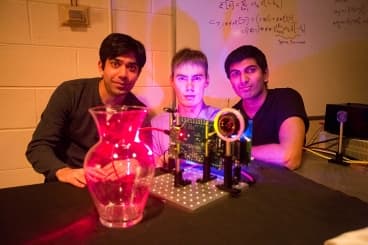MIT Developed Nano Camera Works At The Speed Of Light, Price Is $500
MIT Media Lab churns out interesting projects and new technologies every now and then. The latest innovation coming out of the minds of three MIT Researchers, namely Ayush Bhandari, Refael Whyte and Achuta Kadambi is what they call a 'Nano-Camera'. Priced at $500, this nano camera works at the speed of light and therefore has got its applications in variety of sectors ranging from medical imaging and collision-avoidance detectors for cars, to improving the accuracy of motion tracking and gesture-recognition devices used in interactive gaming. This innovative 3D camera was first presented at the Siggraph Asia event in Hong Kong.
The technology used by Microsoft in the 2nd generation Kinect called 'Time of Flight' is what served the basis for this Nano Camera. This technology calculates location of objects based on how long it takes a light signal to reflect off a surface and return to the sensor. What makes this application of existing technology more interesting is the fact that this camera's functioning won't get hampered in the presence of rain, fog, or even translucent objects. This has been achieved using an encoding technique commonly used in the telecommunications industry to calculate the distance a signal has travelled, Mr. Ramesh Raskar, an associate professor of media arts and sciences and leader of the Camera Culture group within the Media Lab, who developed the method alongside Kadambi, Refael Whyte, Ayush Bhandari, and Christopher Barsi at MIT and Adrian Dorrington and Lee Streeter from the University of Waikato in New Zealand. “Using the current state of the art, such as the new Kinect, you cannot capture translucent objects in 3-D," Achuta Kadambi says. “That is because the light that bounces off the transparent object and the background smear into one pixel on the camera. Using our technique you can generate 3-D models of translucent or near-transparent objects.â€

MIT students (left to right) Ayush Bhandari, Refael Whyte and Achuta Kadambi pose next to their "nano-camera" that can capture translucent objects, such as a glass vase, in 3-D.
While existing uses of this technology have only found the most expensive applications, the new “nano-camera†probes the scene with a continuous-wave signal that oscillates at nanosecond periods. Therefore, by using simple and cheap light-emitting diodes (LEDs) that can strobe at nanosecond periods, the camera can reach a time resolution within one order of magnitude of femtophotography while costing just $500. The team calls their new model 'Nanophotography' and Bhandari shares, “People with shaky hands tend to take blurry photographs with their cellphones because several shifted versions of the scene smear together. By placing some assumptions on the model — for example that much of this blurring was caused by a jittery hand — the image can be unsmeared to produce a sharper picture.â€
MIT researchers take pride in sharing that the combination of techniques and skills required to bring advanced computation and building devices based on these is all present in the work going on in their labs. So, what's the dream? - From devices like Kinect to the ones like the Nano Camera that can be used for sophisticated applications, everything is soon going to be possible at cheaper prices than ever before and soon!
Source: #-Link-Snipped-#
The technology used by Microsoft in the 2nd generation Kinect called 'Time of Flight' is what served the basis for this Nano Camera. This technology calculates location of objects based on how long it takes a light signal to reflect off a surface and return to the sensor. What makes this application of existing technology more interesting is the fact that this camera's functioning won't get hampered in the presence of rain, fog, or even translucent objects. This has been achieved using an encoding technique commonly used in the telecommunications industry to calculate the distance a signal has travelled, Mr. Ramesh Raskar, an associate professor of media arts and sciences and leader of the Camera Culture group within the Media Lab, who developed the method alongside Kadambi, Refael Whyte, Ayush Bhandari, and Christopher Barsi at MIT and Adrian Dorrington and Lee Streeter from the University of Waikato in New Zealand. “Using the current state of the art, such as the new Kinect, you cannot capture translucent objects in 3-D," Achuta Kadambi says. “That is because the light that bounces off the transparent object and the background smear into one pixel on the camera. Using our technique you can generate 3-D models of translucent or near-transparent objects.â€

MIT students (left to right) Ayush Bhandari, Refael Whyte and Achuta Kadambi pose next to their "nano-camera" that can capture translucent objects, such as a glass vase, in 3-D.
While existing uses of this technology have only found the most expensive applications, the new “nano-camera†probes the scene with a continuous-wave signal that oscillates at nanosecond periods. Therefore, by using simple and cheap light-emitting diodes (LEDs) that can strobe at nanosecond periods, the camera can reach a time resolution within one order of magnitude of femtophotography while costing just $500. The team calls their new model 'Nanophotography' and Bhandari shares, “People with shaky hands tend to take blurry photographs with their cellphones because several shifted versions of the scene smear together. By placing some assumptions on the model — for example that much of this blurring was caused by a jittery hand — the image can be unsmeared to produce a sharper picture.â€
MIT researchers take pride in sharing that the combination of techniques and skills required to bring advanced computation and building devices based on these is all present in the work going on in their labs. So, what's the dream? - From devices like Kinect to the ones like the Nano Camera that can be used for sophisticated applications, everything is soon going to be possible at cheaper prices than ever before and soon!
Source: #-Link-Snipped-#
0
